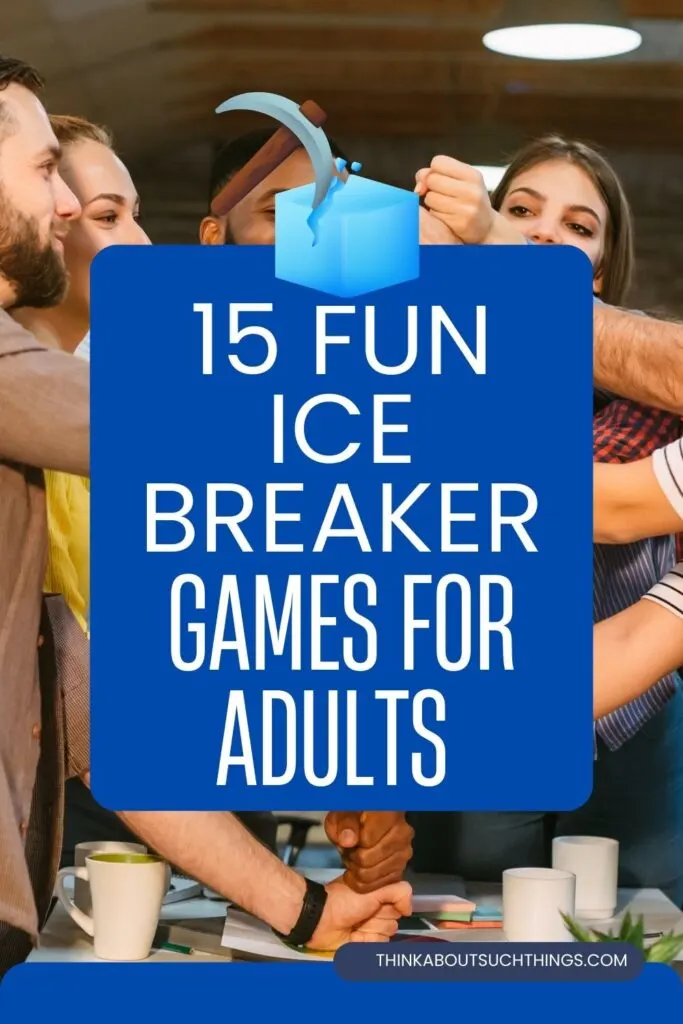In the world of corporate events and team-building activities, icebreaker games are the unsung heroes.
They offer a light-hearted way to get people talking, laughing, and connecting on a deeper level. Here’s why they’re indispensable:
- Foster Connections: Break down social barriers and create a sense of camaraderie.
- Boost Morale: Lighten the mood and provide a fun break from routine tasks.
- Enhance Communication: Encourage open dialogue and improve team collaboration.
- Spark Creativity: Stimulate creative thinking and problem-solving skills.
And they are down right fun! My team in ministry always loved starting the meeting with an ice breaker or team building activity.
Ok let’s now discover some simple icebreakers!

Icebreaker Games for Adults
1. Two Truths and a Lie
How to Play:
Gather Players: The game works best with a small group, but it can be played with any number of people.
Prepare Statements: Each player thinks of three statements about themselves. Two of these statements should be true, and one should be a lie.
Share Statements: One player shares their three statements with the group.
Guess the Lie: The other players try to guess which statement is the lie.
Reveal the Truth: The player reveals which statement was the lie.
Continue the Game: The next player takes their turn, and the game continues until everyone has had a chance to share their statements.
What It Teaches:
- Observation: Team members learn to pay close attention to details.
- Communication: Encourages open discussion and sharing.
Variations:
- Large Groups: Divide into smaller groups for more intimate interaction.
- Small Groups: Play in a single group to strengthen team bonds.
2. Human Knot
How to Play:
Gather Players: You’ll need a group of at least 6-10 people. The more, the merrier!
Form a Circle: Have everyone stand in a circle, shoulder to shoulder.
Create the Knot: Each person reaches out and grabs the hand of someone across the circle. Make sure no one holds hands with the person directly next to them.
Untangle the Knot: Without letting go of each other’s hands, the group must work together to untangle themselves into a circle. This requires communication, cooperation, and sometimes a bit of flexibility!
Complete the Circle: The game ends when the group successfully untangles into a single circle, with everyone still holding hands.
What It Teaches:
- Teamwork: Requires collaborative effort to solve the puzzle.
- Patience: Teaches the value of patience in complex situations.
Variations:
- Timed Challenge: Set a timer to add urgency.
- Blindfolded Version: Increase difficulty for a fun twist.
3. Bingo Hunt
How to Play:
Create Bingo cards with various traits or experiences (e.g., “Has traveled to Europe,” “Loves spicy food”). Participants mingle to find matches and mark their cards.
What It Teaches:
- Networking: Facilitates meeting and learning about colleagues.
- Initiative: Encourages proactive interaction.
Variations:
- Customized Themes: Tailor the Bingo cards to specific event themes.
- Digital Version: Use online tools for virtual events.

4. Speed Networking
How to Play:
This is exactly like speeding dating, except focused on getting to know someone. Set up pairs of participants. Each pair has a few minutes to introduce themselves before rotating to the next person.
What It Teaches:
- Communication: Improves verbal communication skills.
- Time Management: Encourages concise and impactful conversations.
Variations:
- Topic Prompts: Provide topics to discuss for structured interaction.
- Reverse Speed Networking: Start with deep questions instead of introductions.
5. Would You Rather
How to Play:
Gather Players: You can play with any number of people, making it perfect for small or large groups.
Pose a Question: One player asks a “Would you rather?” question. These questions present two different scenarios or choices, often challenging or humorous. For example, “Would you rather have the ability to fly or be invisible?”
Make a Choice: Each player takes turns choosing which option they would prefer and explaining their reasoning if they want.
Discuss: Encourage discussion about why each person made their choice. This can lead to fun and engaging conversations.
What It Teaches:
- Critical Thinking: Promotes thoughtful decision-making.
- Empathy: Builds understanding of diverse perspectives.
Variations:
- Themed Questions: Tailor questions to fit the event’s theme or industry.
- Rapid Fire Round: Keep the pace quick for added excitement.
6. Desert Island
How to Play:
This game can be played with any number of people, making it great for groups of all sizes. Present the scenario to the group: “You’re stranded on a desert island, and you can only bring a limited number of items with you.”
Choose Items: Decide on the number of items each player can bring (commonly 3-5). Each player then shares what items they would choose and why.
Discuss: Encourage players to explain their choices and discuss the practicality and creativity of each selection. This can lead to interesting conversations about survival, comfort, and personal values.
What It Teaches:
- Prioritization: Highlights decision-making and resource management.
- Creativity: Encourages imaginative thinking.
Variations:
- Team Challenge: Work in teams to decide on shared items.
- Scenario Expansion: You can add variations to the game by specifying categories (e.g., one book, one tool, one luxury item) or by introducing challenges that might affect their choices.
7. The Perfect Square
How to Play:
You’ll need a group of at least 4-8 people.
Prepare Materials: Have a large rope or string tied into a loop, and blindfolds for each participant.
Form a Circle: Have the group stand in a circle, holding the rope with both hands.
Blindfold Participants: Once everyone is holding the rope, blindfold all participants.
Create the Square: The challenge is for the group to work together to form a perfect square with the rope while blindfolded. They must communicate effectively to achieve this.
Remove Blindfolds: Once the group believes they have formed a square, they can remove their blindfolds to see the result.
Discuss: After the activity, discuss what strategies worked, what challenges were faced, and how communication played a role in the process.
What It Teaches:
- Trust: Builds trust among team members.
- Non-verbal Communication: Enhances reliance on alternative communication methods.
Variations:
- Timed Challenge: Add a time constraint for urgency.
- Silent Mode: Complete the task without speaking.
8. Find the Common Thread
How to Play:
Groups of participants find something they all have in common, but it can’t be obvious (e.g., “We all love hiking”).
This game can be played with any number of people, making it suitable for both small and large groups.
Choose a Leader: Select one person to be the leader or moderator for the round.
Select Items or Concepts: The leader picks three or more items, concepts, or ideas that seem unrelated. For example, “a bicycle, a tree, and a computer.”
Find the Common Thread: The other players must work together or individually to find a common thread or connection between the chosen items. Creativity is encouraged, and there can be multiple correct answers.
Share and Discuss: Players share their ideas and discuss the different connections they found. The leader can decide on the most interesting or creative answer, or simply enjoy the variety of responses.
What It Teaches:
- Team Bonding: Encourages participants to find connections.
- Active Listening: Promotes attentive listening skills.
Variations:
- Themed Threads: Focus on commonalities related to work or hobbies.
- Speed Rounds: Quickly find multiple common threads.
9. Office Trivia

How to Play:
Create trivia questions about the company, its history, or general knowledge. Teams compete to answer correctly.
What It Teaches:
- Knowledge Sharing: Increases familiarity with company facts.
- Competitive Spirit: Engages participants in friendly competition.
Variations:
- Themed Trivia: Customize questions to fit event themes.
- Live Host: Engage a host to run the trivia game live.
10. Storytelling Train
How to Play:
Participants sit in a circle. One person starts a story with a sentence. Each subsequent person adds a sentence to continue the story. Players should feel free to be as creative and imaginative as they like. The story can take unexpected twists and turns, making it more fun and engaging.
What It Teaches:
- Creativity: Encourages imaginative and creative thinking.
- Collaboration: Fosters teamwork and collective storytelling.
Variations:
- Themed Stories: Start with a story prompt related to the event.
- Timed Turns: Limit each turn to keep the story moving quickly.
11. Picture Pieces Game
How to Play:
Grab a picture or cartoon that has lots of details. Cut the image up into equal squares for your team members.
Give each person or group one piece of the image with some writing utensial and paper. Instruct them to create an exact copy of their piece of the puzzle big enough to fill the piece of copy paper they’ve been given.
Now, have the group try to make a giant version of the picture you picked out.
What It Teaches:
- Communication: Enhances verbal communication skills.
- Problem Solving: Encourages strategic thinking.
Variations:
- Complex Pictures: Use more intricate images for increased difficulty.
- Timed Challenge: Add a time constraint for more excitement.
12. Memory Wall
How to Play:
Participants write down a memorable moment from work on a sticky note and place it on a wall. Everyone reads and discusses the memories or try to guess which memory goes with who.
What It Teaches:
- Reflection: Encourages reflection on positive experiences.
- Appreciation: Builds a culture of recognition and appreciation.
Variations:
- Themed Memories: Focus on specific types of memories (e.g., successes).
- Interactive Wall: Use digital tools for virtual memory walls.
13. Pictionary
How to Play:
Participants draw a word or phrase while their team guesses what it is within a time limit. Try to give them a theme for either the meeting, season or event.
I recommend using a whiteboard or grabbing one of those giant post-it notes.
What It Teaches:
- Creativity: Stimulates creative thinking and expression.
- Teamwork: Encourages team collaboration and quick thinking.
Variations:
- Themed Words: Customize the words or phrases for your event.
- Digital Version: Use online drawing tools for virtual play.
14. Marshmallow Challenge
How to Play:
Teams have 15-20 minutes to build the tallest freestanding structure using spaghetti, tape, string, and a marshmallow (on top).
For a more simplistic take just have marshmallows and toothpicks.

What It Teaches:
- Innovation: Encourages innovative and out-of-the-box thinking.
- Team Dynamics: Highlights team roles and dynamics under pressure.
Variations:
- Different Materials: Introduce new materials for added complexity.
- Additional Constraints: Add rules to make the challenge harder.
15. The Compliment Circle
How to Play:
Participants sit in a circle. Each person gives a compliment to the person next to them. Continue until everyone has received a compliment.
I like to include a ball in this. You toss the ball and you give a compliment to that person so on and so forth.
What It Teaches:
- Positive Reinforcement: Builds a culture of positivity and encouragement.
- Self-Esteem: Boosts confidence and morale.
Variations:
- Anonymous Compliments: Write compliments on paper for anonymity.
- Themed Compliments: Focus on work-related accomplishments.
Wrapping Up
Icebreaker games aren’t just a fun pastime; they are powerful tools for building stronger, more cohesive teams. Implementing these activities will not only make your events more enjoyable but will also foster a positive, collaborative environment.
Have a favorite icebreaker game that wasn’t mentioned? Share it with us in the comments! Let’s keep the conversation going and continue building connections.

Melissa is a passionate minister, speaker and an ongoing learner of the Bible. She has been involved in church and vocational ministry for over 18 years. And is the founder of Think About Such Things. She has the heart to equip the saints by helping them get into the Word of God and fall more in love with Jesus. She also enjoys family, cooking, and reading.
She has spoken in churches in California, Oregon, Texas, and Mexico and has been featured in Guidepost Magazine and All Recipes Magazine. Read More…
